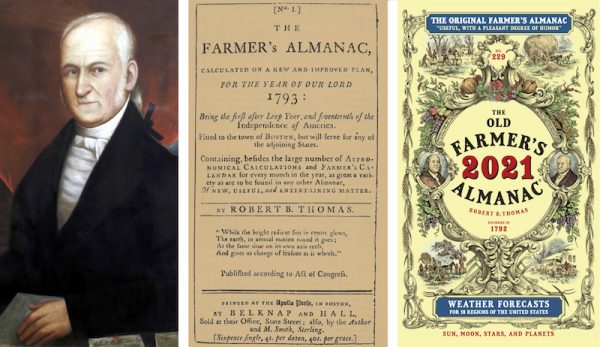
Sporting a soft yellow background and centuries-old illustrations, the cover looks largely the same from year to year. Still, don’t let that fool you. “The goal of every issue of The Old Farmer’s Almanac is to be as modern as the moment,” explains editor Janice Stillman.
Stillman has shepherded The Old Farmer’s Almanac since 2000. She’s the publication’s first female editor—and its 13th editor to date.
“When I was hired, Judson ‘Jud’ Hale, who is the editor emeritus, had said to me, ‘If you have any fear of the number 13, I can hire somebody for a couple of weeks, they can come in and be 13, and you can come back and be 14th,’” she laughs.
But her stint has been plenty lucky. “It’s really been an honor to be the editor of this American icon and the oldest continuously published periodical in North America,” she says.
With its first issue released in 1793, the almanac certainly is old.
In the Beginning
Robert B. Thomas—born on April 24, 1766—originally founded what he dubbed “The Farmer’s Almanac” in 1792. The regional publication included this lengthy subtitle: “Calculated on a New and Improved Plan, for the Year of Our Lord, 1793…. Fitted to the Town of Boston, But Will Serve for Any of the Adjoining States. Containing, Besides the Large Number of Astronomical Calculations and Farmer’s Calendar for Every Month in the Year, as Great a Variety as are to be Found in Any Other Almanac, of New, Useful, and Entertaining Matter.”
“It was a bit of a calculator in the early days, and even its own kind of computer,” Stillman says. “It’s always been a reference book. It’s something people turn to for advice and insight and information.
“And, true to Robert B. Thomas, maybe a bit of a giggle or smile.”
Read more: Smartphone apps can provide a wealth of homesteading information in a modern media.
The Nature of the Almanac
Since its inception, the almanac was intended to be a “calendar of the heavens.” As such, you’ll find a year’s worth of rising and setting suns and moons, day lengths and conjunctions of planets and stars. You’ll also see a good dollop of astrology, weather predictions and more.
“There’s a certain formula to the content,” Stillman notes. “The whole book is about the natural world and the world around us.”
She continues, “It really speaks to the year in so many different ways, whether it be the gardening, the weather, the home remedies, the recipes, the anniversaries, information on pets and general themes.”
Old Meets New
In its way, 2021’s Old Farmer’s Almanac reflects current challenges we face, including climate change. “We are trying to put that in perspective for folks a little bit,” Stillman says.
To that end, the issue features an article on rising ocean levels penned by Brian M. Fagan. (Fagan is the author of several books, including The Attacking Ocean: The Past, Present, and Future of Rising Sea Levels.) “We had not covered it, and it seemed like a good thing to speak to, because it was more in the headlines than it had been before,” Stillman says.
The almanac’s resident weather forecaster also has his finger on the pulse of climate change. “Our forecasts are made with three scientific disciplines. That sets it apart from just about everybody else out there,” she says.
Those disciplines include climatology, meteorology and solar science—the study of sunspots and other solar activity.
“The activity on the sun has been very quiet—actually quieter than in more than 100 years—and we state this in the general weather forecast,” Stillman says. “Historically, that has meant cooler-than-normal temperatures on Earth. However, the belief is that there is so much greenhouse gas in the atmosphere that it could be having an influence.”
Read more: Across the globe, growers struggle to keep up with changing climate.
Other Changes
There are a couple of items dating back to the earliest issues that you won’t find these days. “At the time, it was only distributed through southern New England. So, you had the vacation dates for Harvard University and Dartmouth University, because folks needed to call the kids back from school to work on the farm,” Stillman reports.
It also included distances between specific places, because maps and odometers weren’t yet commonplace.
Among the almanac’s recent additions? Features on farmers from the U.S. and Canada. “The profiles of farmers are really our salute to the people who grow our food,” Stillman explains. “We wanted to recognize the younger farmers coming on and the older folks who’ve been feeding us during their lifetimes.”
As for something Robert B. Thomas likely never could’ve imagined? You can also find related, expanded content online via www.almanac.com.




